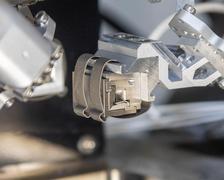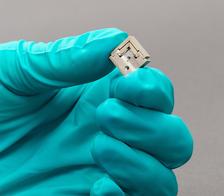Lens cubes with diamond lenses (in the centre) are routinely used for imaging at a resolution of sub-60 nm at the Ptychographic Nano-Analytical Microscope (PtyNAMi) at the PETRA III beamline P06 (Credit: Marta Mayer, DESY)
Diamond is an excellent material for refractive X-ray lenses to focus very bright X-rays, which are generated by 4th generation light sources in particular. Fabrication of these lenses has been very challenging so far. However, a research team at DESY Photon Science has developed novel diamond lens cubes containing stacks of femtosecond-laser-ablated diamond lenses with integrated phase plates. These lenses enable perfect focusing without aberrations.
Traditionally, refractive X-ray lenses have suffered from image aberrations that could not be compensated for. A previous solution from the same research team used external aberration compensation, which required difficult alignment and expertise, making it difficult for non-experts to use. This innovative lens cube contains several phase plates—one per ten lenses— that correct wavefront errors directly inside the assembly. The result is an almost diffraction-limited X-ray focus as small as 52 nm × 51 nm at 14 keV, maintaining its quality across a broad energy range. These findings are published in the journal Optics Express.
Diamond lenses offer superior radiation hardness and thermal conductivity, as well as excellent refractive power and low attenuation. The manufacturing process by ablation enables the fabrication of complex optics. Despite state-of-the-art fabrication processes, residual aberrations cannot be fully avoided. By embedding corrective plates tailored to counteract these aberrations, image distortions can be largely compensated in each lens cube. The result is a compact optic that is easy to align.
Tested at the PETRA III beamline P06 at DESY, a 60-lens cube without correction produced a 62 nm × 53 nm spot at 14 keV, with visible distortions. Adding the integrated phase plates improved the spot size to 52 nm × 51 nm and enhanced the image quality, resulting in a diffraction-limited focus. The imaging capabilities were demonstrated using a Siemens-star fluorescence scanning test pattern, which confirmed that 50 nm features were clearly resolved. “To our knowledge, this is the smallest focus reported by diamond lenses so far”, says Wenxin Wang, the study’s first author.
These lens cubes combine high-precision diamond lens fabrication with built-in aberration correction to deliver compact, energy-flexible focusing for X-ray microscopy at synchrotron radiation or X-ray free-electron laser sources. Users at the Ptychographic Nano-Analytical Microscope (PtyNAMi) on beamline P06 now routinely use the lens cubes for sub-60-nm imaging. This work represents an important milestone in the development of instrumenation for the planned ultimate 4D microscope, PETRA IV—the upgrade of PETRA III to a fourth-generation source.
In the future, the design could be optimised for high-energy X-rays and support XFEL experiments with intense pulses. “This integrated approach can overcome current limitations in lens manufacturing and advance nano-imaging technologies by providing robust, diffraction-limited performance in a plug-and-play package," says Frank Seiboth, DESY scientist and last author of the study.
Christian Schroer, DESY lead scientist for PETRA III and one of the co-authors of the paper, added, “The lens cube has great potential. Together with DESY's Innovation and Technology Transfer Department (ITT), our research team founded a business unit to supply customized diamond optics not only for PETRA III and PETRA IV in the future, but also for other research facilities. Additionally, we are planning a possible start-up company."
Reference:
Wenxin Wang, Ralph Döhrmann, Stephan Botta, Anders Madsen, Christian G. Schroer, and Frank Seiboth, Diamond X-ray lens cubes with integrated aberration compensation, Opt. Express 33 (2025), DOI: 10.1364/OE.562556








